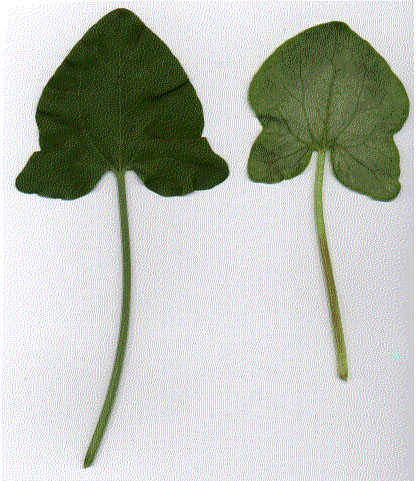| Various different plants are called sorrel. The common denominator is that they have more-or-less sour tasting foliage. The leaves of most such plants are relished by many people. We eat them raw while in our gardens, or while strolling. We add them to salads or make sorrel soup. Many of the leaves are lemony, some are a tad bitter, others pure acid. Although the original plants called sorrel were European and in the buckwheat family (POLYGONACEÆ) nowadays plants of varied families from around the world are also called sorrel -- or are used as sorrel substitutes. Below is a list of some. With most of these the sour flavor comes from oxalic acid, and people should not eat it in gross quantity, as doing so can lead to formation of kidney stones. This is why Rhubarb leaves are not eaten. It would be difficult to eat enough sorrel to cause problems. |
| Hibiscus Sabdariffa -- Jamaica or Red Sorrel -- MALVACEÆ -- A tropical annual. |
| Mahonia nervosa aka Berberis nervosa -- Low Oregon-Grape -- BERBERIDACEÆ -- A west coast North American evergreen shrub whose flowers and tender young leaves taste like sorrel. |
| Opuntia Engelmannii aka O. phæacantha -- Prickly Pear (Cactus) -- CACTACEÆ -- A western N American cactus whose yellow flowers taste sorrel-ish. |
| Oxalis spp. -- Wood Sorrel -- OXALIDACEÆ -- Many perennial species from around the world; some weedy, others garden ornamentals. |
| Oxydendrum arboreum -- Sorrel Tree or Sourwood -- ERICACEÆ -- An eastern U.S. deciduous tree. |
| Oxyria digyna -- Mountain or Alpine Sorrel -- POLYGONACEÆ -- A Northern Hemisphere mountain perennial. |
| Pelargonium acetosum -- Sorrel Geranium -- GERANIACEÆ -- A South African shrublet. |
| Polygonum amphibium -- Water Smartweed -- POLYGONACEÆ -- A semi-aquatic perennial of the N Hemisphere. |
| Portulacaria afra -- Elephant Bush or Grass -- PORTULACACEÆ -- A South African shrub or small tree. |
| Rumex Acetosa -- Garden Sorrel -- POLYGONACEÆ -- A Eurasian perennial. |
| Rumex Acetosella -- Sheep Sorrel -- POLYGONACEÆ -- A Eurasian weed. |
| Rumex scutatus -- French Sorrel -- POLYGONACEÆ -- A Eurasian perennial. |
| In my garden I did or do grow most (9 of 12) of the above. I would also grow the Sorrel Tree but that I find it the least useful. In addition, other species of Mahonia and its close cousin Berberis also have their young tender leaves and flowers sorrel-flavored. And many other species of Polygonum, Persicaria and Rumex do too. I merely listed those that I found best. |
The illustration shows French Sorrel (Rumex scutatus). The plain leaf version is rarely cultivated these days compared to the variegated one called 'Silver Shield'. This plant is easily grown and tolerant of dryness, shade, wet soil, and so on. In my garden the plain green-leaf plant reseeds, but 'Silver Shield' never does. Also the plain leaf plant is more cold-hardy and grows larger.
Back |

scan by ALJ |

